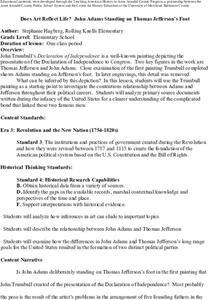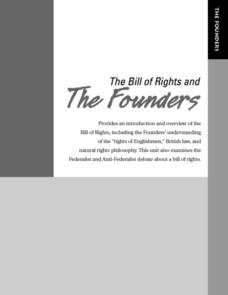Curated OER
The New Republic
Learners research the Federalists and Anti-federalists. In the lesson on state legislature, students use primary sources to create a brochure and write an essay that illustrates federalist and anti-federalists viewpoints.
National Endowment for the Humanities
Lesson 2: The Debate in Congress on the Sedition Act
Pupils research and discuss the provisions in the Constitution that supported the arguments for and against the Sedition Act. They articulate objections to and arguments in favor of the Sedition Act.
Center for History Education
Why is John Adams Standing on Thomas Jefferson's Foot?
Was it a bromance, or were they frenemies? Young historians use a controversial portrait and letters between Thomas Jefferson, John Adams, and others to evaluate the relationship between the two Founding Fathers. Examining the primary...
National Endowment for the Humanities
Lesson 2 James Madison: The Second National Bank—Powers Not Specified in the Constitution
How much power is too much power for the federal government? Scholars use primary documents and constitutional research in groups to analyze the creation of the Second National Bank under James Madison. This is the second lesson of a...
Curated OER
Arguments Against Ratifying the Constitution
Learners define federalism, Federalist, and Anti-Federalist, debate issue of ratification in classroom convention, and take vote on whether to add bill of rights. Three lessons on one page.
Curated OER
A Lesson To Accompany "The First Bank of the United States: A Chapter in the History of Central Banking"
Here is an interesting topic. Learners examine the economics that led to the founding of the First Bank of America. They participate in a reader's theater experience depicting the debate between Alexander Hamilton and Thomas Jefferson...
Constitutional Rights Foundation
Naturalized Citizens and the Presidency
Article II, Section 1 of the U.S. Constitution takes center stage in a lesson that asks class members to assume the role of state senators, debate a resolution to amend the U. S. Constitution to permit naturalized citizens to run for...
Curated OER
The Ratification Debate
Eighth graders investigate the debate in order to understand the Ratification in context of the period of history being studied. They read text answer questions through identifying the differences between Federalists and Antifederalists.
Curated OER
The Bill of Rights and the Founders
Students explain similarities between historical statements of rights and their modern applications, explore ideas of "Rights of Englishmen" and natural rights, discuss evolution of concept of rights and its impact on Bill of Rights,...
Curated OER
Lesson on Federalism
Eleventh graders study Federalism and delegated, reserved, and concurrent powers. They participate in a simulation in which they role-play Federalists and Anti-federalists debating which powers should be categorized as delegated,...
Curated OER
Constitutional Convention
Students engage in a role-playing situation to illustrate the kinds of compromised that were made a teh Constitutional Convention. They write three short 1-2 paragraph arguments and then present their arguments to the class at the...
National Endowment for the Humanities
Lesson 4 James Madison: Internal Improvements Balancing Act—Federal/State and Executive/Legislative
Who has the power? The founding fathers asked the same question when the United States was formed. Learners explore issues that arose during Madison’s presidency that raised constitutional questions. Through discovery, discussion, and...
Curated OER
Building the State (1781-1797)
For this online interactive history worksheet, learners respond to 9 short answer and essay questions about the vision of the Republicans and the Federalists.
Curated OER
The Alien and Sedition Acts
Students perform research in the wake of the attacks on the World Trade Center and the Pentagon, a debate has begun over augmented security and surveillance, versus safeguards for personal freedoms. This debate is certain to occupy our...
Ashbrook Center at Ashland University
Bill of Rights
Do citizens need protection from the federal government? Scholars investigate why the framers of the Constitution created the first 10 amendments and what these amendments mean to citizens of the United States more than 200 years later....
National Constitution Center
Interactive Constitution
Did you know there are seven Articles and 27 Amendments to the US Constitution? Explore each and every one of them, including the Bill of Rights and other rights around the world, in a super neat US Constitution interactive.
Curated OER
James Madison: From Father of the Constitution to President
Students investigate reasons why James Madison is called the "Father of the Constitution." They discuss three events during his presidency that raised constitutional questions and look at Madison's opinions of those questions. They...
Curated OER
"Father" of Our Country vs. "Father" of the Bill of Rights
Students examine the relevance of the Bill of Rights. In this Bill of Rights lesson, students study the parts of the Constitution and the ten amendments. They investigate the rights and responsibilities that accompany being an American....
Digital History
The New Nation
George Washington and the new nation of the United States of America faced many problems in their inaugural years. Use this learning exercise as a straightforward approach to learning about the reasons the country was experiencing a lack...
Curated OER
Paving the Road to the Constitution
Eighth graders argue for or against the ratification of the U.S. Constitution. In this U.S. government lesson, 8th graders complete four activities that encourage them to examine the strengths and weaknesses of the Articles of...
Curated OER
The First Years of the Union (1797-1809)
In this online interactive history worksheet, students respond to 11 short answer and essay questions about the United States between 1797 and 1809. Students may check some of their answers on the interactive worksheet.
Curated OER
Understanding James Madison The Father of the Constitution
Students research James Madison and create a table of his strengths and weaknesses. In this James Madison instructional activity, students read Jean Fritz's, The Great Little Madison, while developing their research skills, vocabulary...
Curated OER
The Alien and Sedition Acts
Middle schoolers discover the conflicts that arose between the political parties over issues of foreign policy and economics. Using the Internet, they research the Alien and Sedition Acts and how they relate to the U.S. Constitution....
Curated OER
Teaching With Documents Lesson Plan:Launching the New U.S. Navy
Pupils demonstrate understanding of the issues related to the creation and ratification of the United States Constitution and the new Government it established.

























